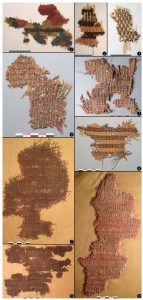 Alexander S. Pakhunov1,*, Irina I. Elkina1,**, Pavel E. Tarasov2,***, Mayke Wagner3,****, Umar Yu. Kochkarov1,*****, Ekaterina G. Devlet 4,******
Alexander S. Pakhunov1,*, Irina I. Elkina1,**, Pavel E. Tarasov2,***, Mayke Wagner3,****, Umar Yu. Kochkarov1,*****, Ekaterina G. Devlet 4,******
1 Institute of Archeology RAS, Moscow, Russia
2 Free University, Berlin, Germany
3 German Archaeological Institute, Berlin, Germany
4 Institute of Archeology RAS, Moscow; Far Eastern Federal University, Vladivostok, Russia
*E-mail: science@pakhunov.com
**E-mail: ira-elkina@yandex.ru
***E-mail: ptarasov@zedat.fu-berlin.de
****E-mail: mayke.wagner@dainst.de
*****E-mail: umar_k@mail.ru
******E-mail: eketek@yandex.ru
Keywords: carpets, quality of wool, Great Silk Road, Moshchevaya Balka, Podorvannaya Balka.
A significant part of the textile woolen finds from the early medieval Alan burials in the rock cemeteries of the North-Western Caucasus are woolen carpets, both produced locally and imported. The main types are pile carpets and those without pile. The paper presents the findings on the production technology and wool quality of three samples from the Moshchevaya Balka cemetery and six samples from the Podorvannaya Balka cemetery. For three of them, radiocarbon-calibrated dates were obtained in the interval between the early 8th–the middle 10th century. Technological analysis of wool carpets of four types established that the difference consisted not only in the weaving techniques. Each type is characterized by the use of specific raw wool. The imported carpets were made of high quality wool, typical for regions with a developed tradition of sheep breeding. Carpets with pile bands were produced from medium quality wool. For polychrome pile carpets, they used both wool of mixed type, containing down, intermediate, and coarse fibers, and more homogenous wool with almost no coarse fibers, which, perhaps, indicates a higher stage of sheep breeding development in the importing region. Local carpets are made of two types of wool – the light and the dark one, their quality varying considerably, including within one item. For light wools, they used both dyed and undyed fibers, while the dark ones were not dyed. In the wool of local breeds there is a large amount of coarse fibers, which distinguishes them from other samples.
DOI: 10.31857/S086960630003390-8







